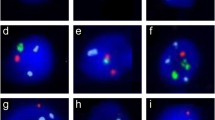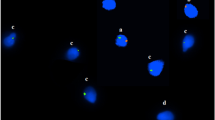Abstract
Purpose: The effect of paternal age on the nondisjunctionof sex chromosomes is controversial. Also, the prevalenceof chromosomal anomalies in infertile patients iscontroversial, it has been reported that the sex chromosomalaneuploidy rate following treatment with intracytoplasmic sperminjection (ICSI) is higher than in naturally conceivedpregnancies. We investigated the influence of paternal age andoligozoospermia on the nondisjunction of spermatozoa.
Methods: We determined the rate of aneuploidy forgonosomes and autosomes, using two-color fluorescence in situhybridization (FISH) of the X and Y chromosomes andchromosomes 12 and 18 in 10 donors under 25 years of agewho had a normal sperm count (≤20 × 106/ml), 10 donorsover the age of 39 years with idiopathic infertility andnormozoospermia (≤20 × 106/ml), and 5 oligozoospermicdonors (<20 × 106/ml).
Results: There was no obvious relationship betweenincreasing age and autosomal disomy (disomy 12 and disomy 18).Neither autosomal disomy nor diploidy was increased inany group. The frequency of X-, Y-, XX-, and YY-bearingsperm did not differ significantly among groups, but thefrequency of XY-bearing sperm was significantly higher inthe older infertile group than in the control donors.
Conclusions: The incidence of nondisjunction of paternalsex chromosome in meiosis I was higher in older men withidiopathic infertility. The present results suggest that therisk of producing XXY fetuses is higher among men >39years of age with idiopathic infertility.
Similar content being viewed by others
REFERENCES
Kamiguchi Y, Mikamo K: An improved, efficient method for analyzing human sperm chromosomes using zona-free hamster ova. Am J Hum Genet 1986;38:724-740
Matsuda T, Horii Y, Ogura K, Nonomura M, Okada K, Yoshida O: Chromosomal survey of 1001 subfertile males: Incidence and clinical features of males with chromosomal anomalies. Acta Urol Japon 1992;38:803-809
Retief AE, Van ZJ, Menkveld R, Fox MF, Kotze GM, Brusnicky J: Chromosome studies in 496 infertile males with a sperm count below 10 million/mL. Hum Genet 1984;66:162-164
Bonaccorsi AC, Martins RH, Vargas F, Franco JJ, Botler J: Genetic disorders in normally androgenized infertile men and the use of intracytoplasmic sperm injection as a way of treatment. Fertil Steril 1997;67:928-931
Bonduelle M, Wilikens A, Buysse A, Van AE, Wisanto A, Devroey P, Van SA, Liebaers I: Prospective follow-up study of 877 children born after intracytoplasmic sperm injection (ICSI), with ejaculated epididymal and testicular spermatozoa and after replacement of cryopreserved embryos obtained after ICSI. Hum Reprod 1996;11 (Suppl 4):131-155, 156-159
Liebaers I, Bonduelle M, Van AE, Devroey P, Van SA: Sex chromosome abnormalities after intracytoplasmic sperm injec-tion [Letter; Comment]. Lancet 1995;346:1095
Guttenbach M, Martinez EM, Michelmann HW, Engel W, Schmid M: Incidence of diploid and disomic sperm nuclei in 45 infertile men. Hum Reprod 1997;12:468-473
Miharu N, Best RG, Young SR: Numerical chromosome abnormalities in spermatozoa of fertile and infertile men detected by fluorescence in situ hybridization [see Comments]. Hum Genet 1994; 93:502-506
Moosani N, Pattinson HA, Carter MD, Cox DM, Rademaker AW, Martin RH: Chromosomal analysis of sperm from men with idiopathic infertility using sperm karyotyping and fluorescence in situ hybridization. Fertil Steril 1995;64:811-817
Bernardini L, Martini E, Geraedts JP, Hopman AH, Lanteri S, Conte N, Capitanio GL: Comparison of gonosomal aneuploidy in spermatozoa of normal fertile men and those with severe male factor detected by in-situ hybridization. Mol Hum Reprod 1997;3:431-438
Griffin DK, Abruzzo MA, Millie EA, Sheean LA, Feingold E, Sherman SL, Hassold TJ: Non-disjunction in human sperm: Evidence for an effect of increasing paternal age. Hum Mol Genet 1995;4:2227-2232
Rouseaux S, Hazzouri M, Pelletier R, Monteil M, Usson Y, Sele B: Disomy rates for chromosomes 14 and 21 studied by fluorescent in-situ hybridization in spermatozoa from three men over 60 years of age. Mol Hum Reprod 1998;4:695-699
Gaulden ME: Maternal age effect: the enigma of Down syn-drome and other trisomic conditions. Mutat Res 1992;296:69-88
Hassold TJ, Jacobs PA: Trisomy in man. Annu Rev Genet 1984;18:69-97
Antonarakis SE, Petersen MB, McInnis MG, et al.: The meiotic stage of nondisjunction in trisomy 21: Determination by using DNA polymorphisms. Am J Hum Genet 1992;50:544-550
Fisher JM, Harvey JF, Morton NE, Jacobs PA: Trisomy 18: studies of the parent and cell division of origin and the effect of aberrant recombination on nondisjunction. Am J Hum Genet 1995;56:669-675
Zaragoza MV, Jacobs PA, James RS, Rogan P, Sherman S, Hassold T: Nondisjunction of human acrocentric chromosomes: Studies of 432 trisomic fetuses and liveborns. Hum Genet 1994;94:411-417
MacDonald M, Hassold T, Harvey J, Wang LH, Morton NE, Jacobs P: The origin of 47,XXY and 47,XXX aneuploidy: heterogeneous mechanisms and role of aberrant recombination. Hum Mol Genet 1994;3:1365-1371
Lorda SI, Binkert F, Maechler M, Robinson WP, Schinzel AA: Reduced recombination and paternal age effect in Klinefelter syndrome. Hum Genet 1992;89:524-530
WHO (1992) WHO Laboratory Manual for the examination of human semen and sperm-cervical mucus interaction. 3rd ed.
Guttenbach M, Schmid M: Determination of Y chromosome aneuploidy in human sperm nuclei by nonradioactive in situ hybridization. Am J Hum Genet 1990;46:553-558
Coonen E, Pieters MH, Dumoulin JC, Meyer H, Evers JL, Rademakers FC, Geraedts JP: Nonisotopic in situ hybridization as a method for nondisjunction studies in human spermatozoa. Mol Reprod Dev 1991;28:18-22
Martin RH, Chan K, Ko E, Rademaker AW: Detection of aneuploidy in human sperm by fluorescence in situ hybridiza-tion (FISH): Different frequencies in fresh and stored sperm nuclei. Cytogenet Cell Genet 1994;65:95-96
Williams BJ, Ballenger CA, Malter HE, Bishop F, Tucker M, Zwingman TA, Hassold TJ: Non-disjunction in human sperm: results of fluorescence in situ hybridization studies using two and three probes. Hum Mol Genet 1993;2:1929-1936
Bischoff FZ, Nguyen DD, Burt KJ, Shaffer LG: Estimates of aneuploidy using multicolor fluorescence in situ hybridization on human sperm [published Erratum appears in Cytogenet Cell Genet 1995;69 (3-4):189]. Cytogenet Cell Genet 1994; 66:237-243
Martin RH, Ko E, Chan K: Detection of aneuploidy in human interphase spermatozoa by fluorescence in situ hybridization (FISH). Cytogenet Cell Genet 1993;64:23-26
Goldman AS, Fomina Z, Knights PA, Hill CJ, Walker AP, Hulten MA: Analysis of the primary sex ratio, sex chromosome aneuploidy and diploidy in human sperm using dual-colour fluorescence in situ hybridisation. Eur J Hum Genet 1993;1:325-334
Rademaker A, Spriggs E, Ko E, Martin RH: Reliability of estimates of diploid human spermatozoa using multicolour fluorescence in-situ hybridization. Hum Reprod 1997;12:77-79
Guttenbach M, Schakowski R, Schmid M: Incidence of chromosome 3, 7, 10, 11, 17 and X disomy in mature human sperm nuclei as determined by nonradioactive in situ hybridization. Hum Genet 1994;93:7-12
Spriggs EL, Rademaker AW, Martin RH: Aneuploidy in human sperm: results of two-and three-color fluorescence in situ hybridization using centromeric probes for chromosomes 1, 12, 15, 18, X, and Y. Cytogenet Cell Genet 1995;71:47-53
Spriggs EL, Rademaker AW, Martin RH: Aneuploidy in human sperm: the use of multicolor FISH to test various theories of nondisjunction. Am J Hum Genet 1996;58:356-362
Chevret E, Rousseaux S, Monteil M, Pelletier R, Cozzi J, Sele B: Meiotic segregation of the X and Y chromosomes and chromosome 1 analyzed by three-color FISH in human interphase spermatozoa. Cytogenet Cell Genet 1995;71:126-130
Pellestor F: Differential distribution of aneuploidy in human gametes according to their sex. Hum Reprod 1991;6:1252-1258
Mohandas TK, Speed RM, Passage MB, Yen PH, Chandley AC, Shapiro LJ: Role of the pseudoautosomal region in sexchromosome pairing during male meiosis: Meiotic studies in a man with a deletion of distal Xp. Am J Hum Genet 1992;51:526-533
Hassold TJ, Sherman SL, Pettay D, Page DC, Jacobs PA: XY chromosome nondisjunction in man is associated with diminished recombination in the pseudoautosomal region. Am J Hum Genet 1991;49:253-260
Abruzzo MA, Hassold TJ: Etiology of nondisjunction in humans. Environ. Mol Mutagen 1995;26:38-47
Carothers AD, Filippi G: Klinefelter's syndrome in Sardinia and Scotland. Comparative studies of parental age and other aetiological factors in 47,XXY. Hum Genet 1988;81:71-75
May KM, Jacobs PA, Lee M, Ratcliffe S, Robinson A, Nielsen J, Hassold TJ: The parental origin of the extra X chromosome in 47,XXX females. Am J Hum Genet 1990;46:754-761
Hassold TJ, Arnovitz K, Jacobs PA, May K, Robinson D: The oligoparental origin of the missing or additional chromosome in 45,X and 47,XXX females. Birth Defects Orig Article Ser 1990;26:297-304
Tada T, Takagi N, Adler ID: Parental imprinting on the mouse X chromosome: effects on the early development of XO, XXY and XXX embryos. Genet Res 1993;62:139-148
Maeda T, Ohno M, Matsunobu A, YoshiharaK, Yabe N: A cytogenetic survey of 14,835 consecutive liveborns. Jinrui Idengaku Zasshi 1991;36:117-129
Benn PA, Hsu LY, Carlson A, Tannenbaum HL: The centralized prenatal genetics screening program of New York City III: The first 7,000 cases. Am J Med Genet 1985;20;369-384
Hunt PA: Survival of XO mouse fetuses: effect of parental origin of the X chromosome or uterine environment? Develop-ment 1991;111:1137-1141
Russell WL, Kelly EM, Hunsicker PR, et al.: Effect of radiation dose-rate on the induction of X-chromosome loss in female mice. In Report of the United Nations Science Commitee on the Effect of Atomic Radiations. New York, United Nations, 1972
Fitzgerald PH, McEwan CM: Total aneuploidy and age-related sex chromosome aneuploidy in cultured lymphocytes of normal men and women. Hum Genet 1977;39:329-337
Reijo R, Alagappan RK, Patrizio P, Page DC: Severe oligoparental zoospermia resulting from deletions of azoospermia factor gene on Y chromosome. Lancet 1996;347:1290-1293
Veld P, Broekmans FJ, de, FH, Pearson PL, Pieters MH, Kooij R: Intracytoplasmic sperm injection (ICSI) and chromosomally abnormal spermatozoa. Hum Reprod 1997;12:752-754
Gabarron J, Jimenez A, Glover G: Premature centromere divi-sion dominantly inherited in a subfertile family. Cytogenet Cell Genet 1986;43:69-71
Martin RH, Rademaker A: The relationship between sperm chromosomal abnormalities and sperm morphology in humans. Mutat Res 1988;207:159-164
Author information
Authors and Affiliations
Rights and permissions
About this article
Cite this article
Asada, H., Sueoka, K., Hashiba, T. et al. The Effects of Age and Abnormal Sperm Count on the Nondisjunction of Spermatozoa. J Assist Reprod Genet 17, 51–59 (2000). https://doi.org/10.1023/A:1009454114973
Issue Date:
DOI: https://doi.org/10.1023/A:1009454114973




